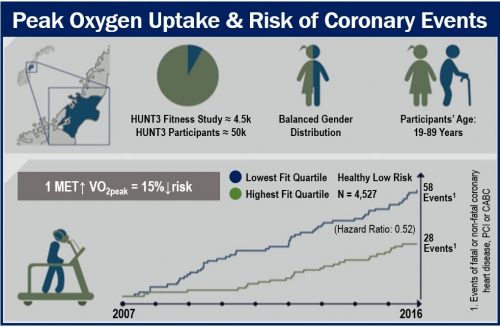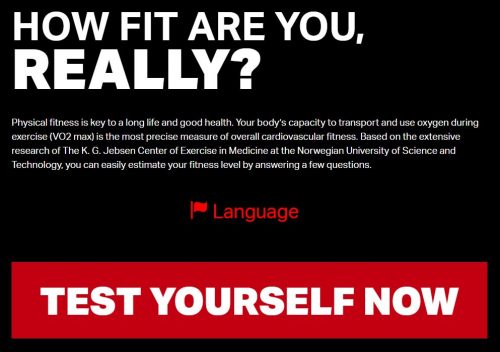
Staying fit can cut people’s risk of heart attack by fifty percent, says a team of researchers. Poor cardiorespiratory fitness can raise people’s risk of a future heart attack, regardless of whether they have symptoms.
These are some of the conclusions of a research team from the Norwegian University of Science and Technology (NTNU). They wrote about their study and findings in the European Heart Journal (citation below). The authors were Jon Magne Letnes, Håvard Dalen, Elisabeth K Vesterbekkmo, Ulrik Wisløff, and Bjarne M Nes.
Heart attack and angina risk
Bjarne Martens Nes, a Researcher at NTNU’s Cardiac Exercise Research Group (CERG), said:
“We found a strong link between higher fitness levels and a lower risk of heart attack and angina pectoris over the nine years following the measurements that were taken.”
“Even among people who seem to be healthy, the top 25 per cent of the most fit individuals actually have only half as high a risk as the least fit 25%.”
CERG researchers measured the cardiorespiratory fitness of 4,527 adult men and women between 2006 and 2008. They had taken part in the HUNT3 population-based health survey in Nord-Trøndelag.
None of the participants had hypertension (high blood pressure), cancer, or cardiovascular disease. The majority of them were considered as having a low risk of cardiovascular disease for the next decade.
Despite all these positive factors, 147 of them were either diagnosed with angina pectoris or suffered heart attacks by 2017.
The coronary arteries in the hearts of heart attack or angina pectoris patients are usually completely blocked or narrowed.
As we get fit heart attack or angina risk falls
The research team analyzed the participants in fitness groups. In other words, they compared participants’ fitness levels in relation to others of the same gender and age.
They found that the risk of heart attack or angina fell as participants’ fitness increased.
According to an NTNU press release:
“The correlation between fitness and cardiovascular risk also held after adjusting for other factors that differed between the most and least fit participants.”

Maximum oxygen uptake indicates how fit you are
This study used maximum oxygen uptake to measure the level of fitness of the participants. This was one of the study’s greatest strength’s, the authors wrote.
Most studies that had linked heart disease risk to fitness levels used less precise fitness calculations. Some of them didn’t even go beyond using participants’ self-reported data.
Dr. Nes explained:
“Maximum oxygen uptake is the most precise measure of fitness.”
Your maximum oxygen absorption determines how fit you are
Our bodies use oxygen to drive metabolic processes that create energy for our muscles. We call the maximum amount of oxygen the body can absorb during physical exercise the ‘maximum oxygen absorption.’
Our oxygen uptake level determines how well our blood vessels, muscles, and heart function.
Regarding people with low oxygen uptake, Dr. Nes said:
“We know that patients with low oxygen uptake are at increased risk of premature death and cardiovascular disease. Our study shows that poorer fitness is an independent risk factor for coronary artery disease, even among healthy women and men who are relatively fit.”
How fit should I be?
The researchers found that even a small increase in physical fitness could have significant benefits. For every increase of 3.5 fitness points, the risk of angina or heart attack declined by 15%, they wrote.
First author, Jon Magne Letnes, a medical doctor and PhD candidate at CERG, said:
“Even though the study is an observational study, and thus limiting conclusions regarding causation, our results should encourage people to use training as preventive medicine. A few months of regular exercise that gets you out of breath can be an effective strategy for reducing the risk of cardiovascular disease.”
Even if you never get fit enough for optimal protection, your risk declines the fitter you get. In other words, even if you become just a little bit fit your risk of heart attack will probably fall.

There is no upper limit
Prof. Sanjay Sharma, who wrote a Commentary that accompanied the NTNU study, said:
“There is apparently no upper limit for training when it comes to the beneficial effects for the heart.”
Prof. Sanjay is a Professor of Inherited Cardiac Diseases and Sports Cardiology at St. George’s University of London. He is also the Medical Director for Virgin London Marathon (the London Marathon). He is considered one of the world’s leading experts in sports and heart disease.
Citation
“Peak oxygen uptake and incident coronary heart disease in a healthy population: the HUNT Fitness Study,” Jon Magne Letnes, Håvard Dalen, Elisabeth K Vesterbekkmo, Ulrik Wisløff, and Bjarne M Nes. European Heart Journal, ehy708. DOI: https://doi.org/10.1093/eurheartj/ehy708.

